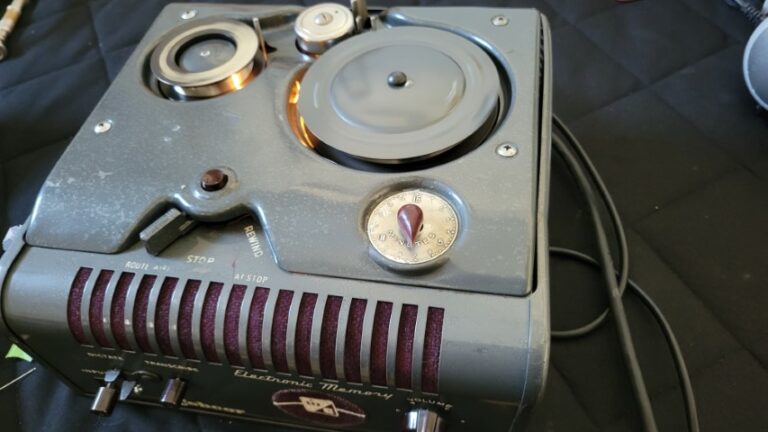
Many people today have never seen a wire recorder. The technology dates back to the 1890s and is the earliest example of magnetic recording. By the 1920s they were commercially available as office dictation machines with a run-time of up to an hour per-spool of wire, which could be erased and reused many times. During WWII wires of battle sounds were played over loudspeakers by the US military to mask the sound of other activities. By the late 1940s machines became available for home use was well, and spools recorded on these home machines represent the majority of what we encounter today. The popularity of wire recorders was brief; they pretty much disappeared by 1955 in favor of the much more practical and reliable open-reel tape recorders (and their later cassette variants) which became the de-facto format of choice well into the 1990s.
Transferring wires today is a tricky job. The design of the machines is fairly simple, but also prone to malfunction, especially when they haven’t been used for many years. The two most common problems encountered today are hum on playback (caused by worn out components in the machine) and the possibility of the wire becoming broken and/or snarled during playback or rewinding. Even though the wire itself seems surprisingly strong, it is still roughly the thickness of a human hair and can break or kink easily if the spools of wire are not wound/rewound properly or have degraded from years of non-use. Simple breaks and minor snarls can usually be repaired with reasonable success, since each second of audio requires 24 inches of wire, and when small bits must be cut out and discarded it only affects a fraction of a second of audio. Playback of an old wire is something that must be monitored carefully to watch for these breaks as they occur, and often many splices are needed in order to capture all of the audio on a spool. Larger snarls are sometimes unsalvageable, and bigger sections of audio must be discarded in order to continue with the transfer. Remember, this wire has been sitting on the spool for 70 or more years, so it is a very unpredictable process.
Once the spool has been transferred (which can take anywhere from 15 minutes to several hours depending on the length and condition of the wire) rewinding occurs at about 10x the speed of playback. Here is where we encounter the most breaks and snarls, so it is important to have made the transfer during the initial playback so the audio is saved. Most clients prefer not to pay for the time that would be spent repairing wire that has already been transferred, so it is sometimes preferable to rewind broken pieces back onto the original spool without making further repairs. Note that even the literature supplied with brand new wire recorders gave instructions for dealing with breaks and tangled wire, so this has always been a common and expected problem.
It is highly recommended that playback/transfer of wires be turned over to someone with experience and a playback machine that works properly. If you don’t know exactly what you are doing, the result could be the loss of precious and now irretrievable audio. Unfortunately, because of the unpredictable nature of wire playback, it is impossible to estimate the cost, and the job must be billed based on the hours spent to make the transfer. If a one-hour spool plays through and rewinds without issues, the cost will be much less than one that breaks every few minutes and requires multiple splices to play all the way through. But once captured, the pieces can be assembled in the digital realm and the sound can be greatly improved with ease.

